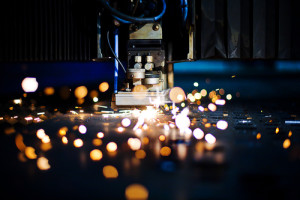When Precision Counts, Count on Laser Cutting Technology
 When Precision Counts, Count on Laser Cutting Technology
When Precision Counts, Count on Laser Cutting Technology
Experienced metal fabricators know that when it comes to projects that require the utmost in precision cutting, there is no cutting corners by using outdated and inefficient equipment. Laser technology has provided the fabrication industry with not only the means to allow for more precise manufacturing, but also a way to make their operations more efficient and less costly.
What is Laser Cutting?
The origin of the word LASER stems from the acronym for “light amplification by stimulated emission of radiation.” Laser cutting is accomplished, true to its name, through a process that stimulates emission. Laser cutters for industrial use are able to cut through flat sheets, piping or structural metals. Cutting is made possible by the laser’s ability to burn, melt or blow away the area to be cut.
Electricity or special lamps used within a closed environment generate the power needed to charge up the material that creates the laser beam. There are three types of laser cutting available to metal fabricators, including:
- CO2 for boring, cutting and engraving
- Nd for boring that requires high-energy
- Nd-YAG for when high power is required
Both the Nd and Nd-YAG lasers are used in the welding process.
Different types of material require different types of laser beams using various methods to allow for cutting. These methods include, but are not limited to:
- Burning stabilized laser cutting
- Cold cutting
- Melt and blow
- Melt blow and burn
- Scribing
- Thermal stress cracking
- Vaporization
A typical laser cutting setup for a metal fabrication shop includes:
- A power source to produce a laser beam
- Positioning table to secure material with clamps, magnets or straps
- Laser material
- Stimulation apparatus
- Mirrors
- Lens for focusing the laser beam
Pros and Cons of Using Lasers for Cutting
Laser cutting is more precise than mechanical cutting methods because machines can be easily contaminated from the materials that are being cut with them. Additionally, their blades are subjected to continual use that can dull them and cause their cuts to be inconsistent which can often lead to wasted material.
With laser cutting, you can expect:
- Cleaner cuts without burrs that require additional processing
- Faster production time
- Less human error
- Improved accuracy resulting in waste reduction
However, using laser cutting machinery does have a few drawbacks. It requires more energy than mechanical cutting methods. Because of the heat process involved, the laser process requires a cooling source, where water is commonly used as a coolant for a heat transfer or chiller system.
Advances Continue to Make Cutting Process More Efficient and Cost-Effective
Improved technology continues to develop cutting equipment that will require less laser gas and power to operate while dramatically improving cutting speeds and accuracy. These advancements help to increase production and transform other areas of the business process for metal fabricators who are taking advantage of this technology to greatly improve their bottom line.

